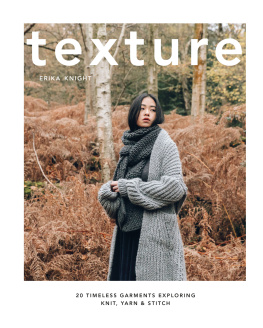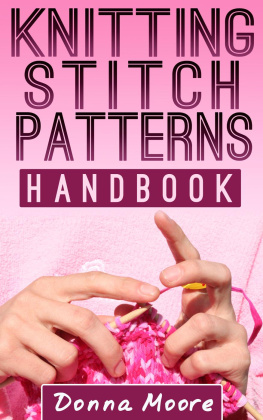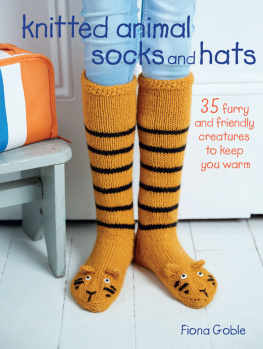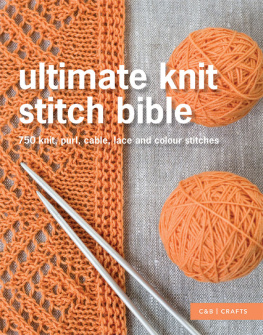
content An art school tutor once told me, It always comes back to the landscape, and you know what it always does. Urban texture and structures, hard surfaces of concrete, metal and glass, or by contrast, tussock grasses, spikey hedgerows, undulating soft hills or rugged rocky outcrops emerging from swirling low-tidal seascapes, shingle and seaweed-strewn beaches: it all inspires me. This book is a personal journey through the landscape, taking in the city, country and coast, seeing patterns and textures in the wild and translating them into yarn, stitch and knit. As a Fine Art student I experimented with paint, scrim, canvas and paper, creating my own sketchbooks with a palette of textures; smooth, matt, rough, torn, cut, fabric embedded in fibreglass, juxtaposed with outlines of soft smudged charcoal, wood or rusted metal. But the 2D surface was never enough and I sought out sculptural forms, learning fit and shape from the fashion department, and watching how the body moves through life drawing. The body became a new canvas for me and texture was my medium.
I have always loved the authenticity of the handmade, the simplicity of creating a practical textile with just two sticks and a continuous thread and then going that extra mile to refine, embellish and make beautiful. For me, design is an organic practice; not prescriptive but experimental, embracing the complexity of the creative process, those thousands of subconscious decisions that one makes instinctively this yarn, that fibre, will it work in this stitch, maybe a different colour, a stripe, a firmer ).


The twenty patterns in this book are designed to offer ways to incorporate and celebrate texture and, in doing so, to slow down, to be absorbed in the creative process of knitting. My mission is simple, to create recipes for slow clothes knitted pieces that become old friends fashion-less, season-less, thoughtful patterns for all modern makers. My passion for texture is fired and fuelled by yarn and fibre. I have been creating, developing, knitting and working with yarns for the fashion and textile industry and for myself, in one way or another, for most of my life.
It is endlessly fascinating that one can create yarn, or at least a continuous thread, out of a great variety of fibres and that there are seemingly limitless possibilities of processes to discover. Simply, yarns are composed of either natural or synthetic fibres. Natural fibres are derived from either plant or animal fibres. Fibres that come from animals are protein fibres and those from plants are vegetable fibres, also known as cellulose. Protein fibres include wool, alpaca, cashmere, vicuna, mohair, llama, camel, vicuna, angora, qiviut, buffalo, yak and silk. Synthetic or man-made fibres are chemically engineered and include rayon, lyocell, nylon, polyester, polypropylene, and acrylic. Synthetic or man-made fibres are chemically engineered and include rayon, lyocell, nylon, polyester, polypropylene, and acrylic.
I prefer to use fibres that are natural and sustainable, manufactured by processes and practices that do not impact negatively on the environment, resources or living standards of those that make them. Wool is quite possibly the ultimate natural, sustainable and renewable fibre. It is insulating, elastic and water- and fire-resistant. Naturally absorbent, wicking moisture away from the skin to keep you warm in winter and cool in summer, ultimately comfortable and hypoallergenic. Wool is hard-wearing and garments made from wool products have long lifespans, meaning they are used or worn for longer than other textile fibre products. Due its porous surface, wool takes dye extremely well.
There are hundreds of different breeds of sheep globally, all producing fleece that is sheared and brought to market. For example, my personal favourite, and arguably the best fleece that Britain has, is that of the Bluefaced Leicester. With its fine, dense yet lightweight fleece due to the nature of its crimped wool this sheep breed produces some of the finest commercial demi-lustre wool in the world. Supremely soft, subtly sheeny and deliciously sumptuous, this is a truly luxurious fibre. Silk is not only elegant, but the strongest natural fibre. It is often considered to be the fibre symbolic of luxury and wealth.
Despite its softness and fluidity, weight for weight it is stronger than a steel rod, as well as being mildew-resistant and antibacterial, making it ideal for clothing. Hemp is the worlds leading renewable resource. It can grow in virtually any soil and is excellent for reclaiming otherwise unusable land. As it is unpalatable to insects it requires no harmful pesticides to produce it. Hemp is 100% natural, durable and with a subtle sheen, this fibre is one of the oldest and most versatile fabrics used in textile production, and it is long-lasting, improving in softness with wear and washing. As a fibre it could replace synthetics because it yields more usable fibre than any other plant.
There are several sustainability issues facing the wider textile industry: Environmental great demand on water for processes such as washing, scouring, dyeing and finishing fabrics. Energy usage for these processes and environmental issues such as toxicity in contaminated water. Use of unsafe pesticides and chemicals. Animal welfare animal husbandry and from sourcing raw materials. Pollution through air and water transmission. Waste products ending up in landfills, along with packaging that is not recyclable or biodegradable.
We need to find sustainable and regenerative processes and direction for the future. We need nature and technology to work together. We need change that has a low impact on our environment. We need to explore alternatives in yarns, fibres, processes, practices and mindsets. Just as with the food that we consume, we need to make informed and considered choices with our purchases and use of materials. We all have a responsibility.
True innovation will come from scientifically exploring biotechnology to develop ecologically friendly performance qualities and cut out unnecessary processes. Knitting is the perfect pursuit to embrace sustainability in yarns, fibres, the products produced and the very practical and pleasurable practice of knitting itself. It is about reusing, recycling, regenerating and reforming blending natural fibres with recycled ones, generating fibre from alternative abundant resources, reusing waste, giving yarns a second life.
Sometimes you may wish to use an alternative yarn to the one specified by a pattern. The yarn may be discontinued, or you may have something in your stash that you prefer but are not quite sure of its weight because it has lost its ball band, or you may wish to use a treasured artisanal yarn that didnt come with a label. I have included in this book two designs that have originated from my own stash of yarns: .
Although I have recommended specific yarns for the designs in this book, you can use substitutes if you like. I endeavour to keep to generic weights of yarn, so that a design can always be replicated in an alternative yarn if preferred. If you decide to use an alternative yarn, use a substituted yarn that is as close as possible to the original in thickness, weight and texture so that it will work with the pattern instructions. There are several factors to consider when substituting a yarn. FIBRE Be aware of the fibre content of the yarn. Animal or protein-based fibres are elastic, flexible and have natural stretch or give, whereas plant fibres are rigid, unyielding and may not deliver the same result.










